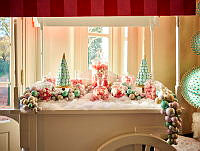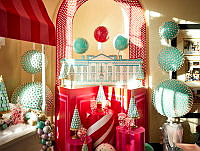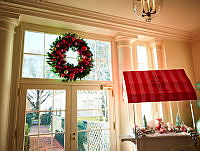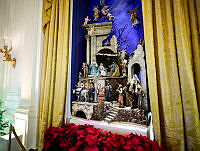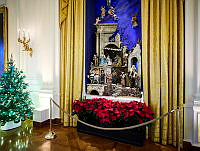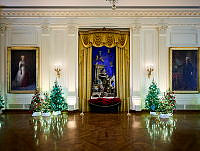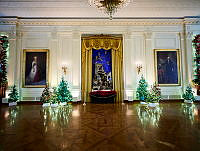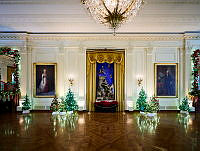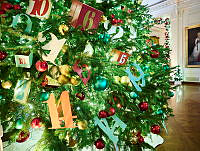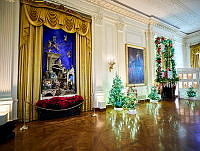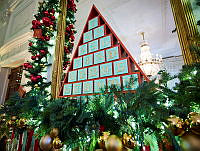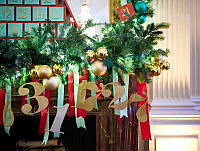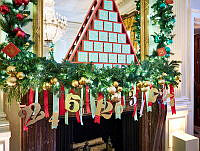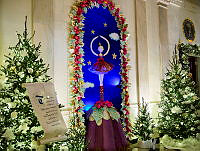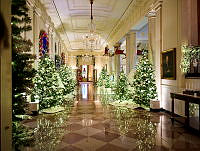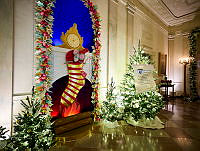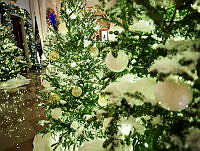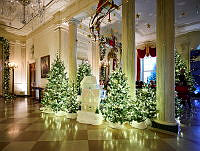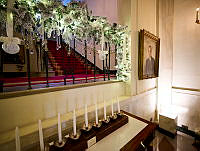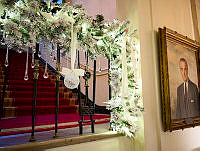History in White House Silver
Copyright © 1983 White House Historical Association. All rights reserved under international copyright conventions. No part of this article may be reproduced or utilized in any form or by any means, electronic or mechanical, including photocopying, recording, or by any information storage and retrieval system, without permission in writing from the publisher. Requests for reprint permissions should be addressed to books@whha.org
One of the most interesting collections of silver of which this country can boast is at the White House. It was begun by President James Monroe in 1818, after the war with Great Britain, and has grown over the years, remaining in continuous use by the Presidents and a constant parade of guests.
Considering the duration of its service at state functions at the White House, it is difficult to isolate the silver from its political history and consider it solely as an example of the decorative arts. Yet as a collection evaluated from that viewpoint, it has great merit, not only because of its quality, but also because of the richness of its historical documentation.
The White House does not have a vast collection of silver, as one might expect at the official residence of a world leader. Much of the explanation for this situation is found in the uncertainty of the country's first leaders over both the role the President was to play in American life and the appropriate manner in which he was to live. A notable example of this uncertainty was the controversy that arose—even before Washington was inaugurated—over the President's proper title. The Senate passed a resolution favoring "His Highness, the President of the United States of America, Protector of their Liberties." This suggestion was defeated in the House. 1

This French wine cooler, made by Jean-Baptiste-ClaudeOdiot, was brought to the White House in 1817 by President James Monroe.
White House Historical AssociationAttitudes in opposition to presidential pomp were also reflected by early presidential salaries that barely kept pace with the burdens inherent in the office. President Thomas Jefferson acknowledged that he emerged from office almost $10,000 poorer because of the expense of running the Executive Mansion.2 As for furnishing the house itself, congressional appropriations were usually lean, considering the basic needs for a house this size, as well as the heavy use to which everything was subjected.
When the first occupants, John and Abigail Adams, moved to the White House in 1800, the East Room, originally designed to be the “Public Audience Chamber,” was still structurally unfinished. It remained so 14 years later, when the British burned the house. The East Room was not completely furnished until late 1829 and was done so then only because many congressmen had found the room embarrassingly empty when Lafayette visited five years earlier.
The "republican simplicity" so valued by Americans caused disappointment and frequent scorn among European visitors, who were accustomed to the elaborate courts maintained by royalty at home. Typical was the reaction of the English traveler Charles William Janson when he beheld the White House in the early 19th century:
"Only part of it is finished. The whole salary of the president would be inadequate to the expense of completing it in a style of suitable elegance.. . . This parsimony destroys every sentiment of pleasure that arises in the mind, in viewing the residence of the president of a nation, and is a disgrace to the country."3
Yet only a few years later, Whig Congressman Charles Ogle of Pennsylvania derided the White House as a "palace as splendid as that of the Caesars and as richly adorned as the proudest Asiatic mansion," filled he said, "with the costly fripperies of Europe."4 It was a battle that would continue through the years. Most of the antiques and art in the White House have been acquired since 1961 through private philanthropy, not government funding.
Opposition notwithstanding, early Presidents attempted to furnish the house in an elegant style commensurate with its purposes. They often looked to Europe, particularly to France, for furniture, decorative accessories, and silver. The result is that today at the White House there are three outstanding collections of early 19th-century European silver. Two are from the French Empire and were purchased by James Monroe and Andrew Jackson. The third is from the Empire's English contemporary, the Regency, and was donated during the Kennedy administration.

This pair of candlesticks, by Roch-Louis Dany, was used by James Monroe while he was American minister to France. The pair was later sold to James Madison.
White House Historical AssociationAll of the silver was made from about 1800 to 1820 and reflects the interest in the antiquities of Rome, Greece, and Egypt that was fashionable in Europe and America at the time. The Monroe and Jackson purchases must have seemed especially appropriate when they were new, since so many Americans found in these motifs symbols of the ideals of virtue, citizen ship, and justice that were incorporated in their own young republic. Even if the first two collections were not associated with the White House, they would still stand as important examples of sophisticated American taste during the early republic.
Three additional examples of European silver were bought by early Presidents for their own use and were eventually added to the White House collection. The English Sheffield tea urn dates from about 1785 and was owned by John and Abigail Adams, who had their monogram "JAA" engraved on its front. It descended in the Adams family until 1944, when it was sold. Twenty years later, it was presented to the White House by Mr. and Mrs. Mark Bortman, of Boston, and their daughter, Jane Bortman Larus.
The pair of candlesticks and two cruet stands were made in 1789 by the French silversmith Roch-Louis Dany (active 1779-1810) for James Monroe, who sold them to James Madison, when the latter was secretary of state. In 1848 Madison's widow, Dolley, and stepson, John Payne Todd, sold the silver to help settle their debts. The silver did not become part of the White House collection until 1931, through a bequest of James C. McGuire, a descendant of the purchaser.

This soup tureen was one of a pair made inParis by Jacques-Henri Fauconnier and bought forthe White House in 1818 by President James Monroe.
White House Historical AssociationPresident Monroe’s Purchases
The first purchase of French silver for the White House might be considered an indirect result of the burning of the house and its contents by the British on August 24, 1814. Dolley Madison did save some of the silver; it survived, bruised and dented as a result of the rough wagon ride out into the country. After the fire, the silver was traded in for new flatware when the Madisons began housekeeping again elsewhere in Washington.
The government moved slowly in reconstructing the White House, which was not ready for occupancy until late in 1817. The new President, James Monroe, was left with the task of refurnishing the mansion, a vast house by American standards. Congress appropriated only $20,000 for furnishings, and the President used almost half of that amount to purchase for the government the furnishings he himself had bought in Paris when he was the American minister. This act led to new political controversy.5
The silver in this purchase included flatware, serving dishes, and the only items that remain in the White House today, four wine coolers. Valued at the time at ten dollars each, the coolers were made by Jean-Baptiste-Claude Odiot (1763-1850), a favorite craftsman of Napoleon. They have feet shaped like sphinxes, a recurring theme in ancient mythology and the French Empire style.
President Monroe turned to France for other new furnishings as well, and in April 1817 he placed the government's order with the American firm of Russell & LaFarge at its offices in Le Havre. The silver was among 41 assorted packages that arrived on the American ship Resolution in the port of Alexandria, Virginia, the following November.
The order consisted of two sets of flatware, one of which was silver-gilt, and a pair of large soup tureens. Tradition has it that a set of pearl-handled knives with silver-gilt blades now at the White House were also part of this purchase.
The soup tureens were made by Jacques-Henri Fauconnier (1776-1839), a pupil of Odiot, who was described by Joseph Russell as "an excellent artist, and honest man."6 Fauconnier's work is also represented in the Jackson purchase, as will be seen. The tureens are still used in the private dining rooms of the President and are marked stylistically by alternating groups of classical musicians and tazzas of fruit flanked on either side by griffins.

This coffeepot made byJacques-Henri Fauconnier is part of the Baron de Tuyll's silver purchased by President Jackson in1833. In high neo-classical taste, thecoffeepot rests on cloven hooves. Thespout terminates in a dog's head. The ivory handle springs froma classical head in silver.
White House Historical AssociationPresident Jackson’s Purchases
The other important collection of French Empire silver was bought 16 years later in 1833 by Andrew Jackson. This silver, weighing a total of 2,693 ounces, cost $4,308.82 and was purchased at the sale of the effects of the deceased Russian minister Major General Baron Feodor Vasil'evich Teil'-fan-Seroskerken (happily abbreviated at the time to Baron de Tuyll).
The baron occupied a house across Lafayette Square from the President's House, where he served as the tsar's representative from June 1822 to March 1826.7 His rich tableware was well known to Washington society, being unusually handsome.
The Jackson acquisition remains surprisingly intact today. Ten round plates and a coffee pot are by Fauconnier and are engraved with the Cyrillic S. Seroskerken's initial. The coffee pot has feet that resemble cloven hooves, a spout culminating in a dog's head, an acanthus-leaf finial, and a handle with a classical head at its base. No other piece of European silver at the White House uses such a vocabulary of disparate design elements.

This image shows the detail of the spout of a neoclassical silver coffeepot made by French silversmith Jacques-Henri Fauconnier before 1833. It was part of a 130-piece silver service that President Andrew Jackson purchased from the Russian minister to the United States, Baron de Tuyll.
White House Historical Association
Above are details of the spout and handle from the Baron de Tuyll's silver purchased by President Jackson in 1833.
White House Historical AssociationThe remaining serving pieces in Jackson's acquisition were all made by Martin-Guillaume Biennais (1764-1843), official silversmith to Napoleon and a great favorite of the Russian aristocracy during the reign of Tsar Alexander I. This portion of the collection includes two soup tureens, four vegetable dishes, and a coffee and tea service, all of which have smooth surfaces and acorn-shaped finials; two cruet stands, two mustard stands, and a number of double salt dips, which are all stylistically united by the use of winged caryatids, female figures that serve as the main supporting members of the piece; and, finally, a number of small bottle stands and two sauceboats and their accompanying stands. The silver-gilt flatware that Jackson bought from the Russian nobleman's estate includes pieces by Francois-Dominique Naudin (active 1806-1834?) and Pierre-Joseph Dehanne (active 1800-1820?), as well as Biennais.

A diminutive serving piece by Biennais from the Baron de Tuyll collection, this mustard stand is borne by caryatids. Its glass liner is a reproduction.
White House Historical AssociationPresident Kennedy’s Acquisitions
The largest collection of European silver at the White House is that made by Paul Storr (1771-1844), the great craftsman of the English Regency, and donated to the White House by Mrs. Dorothea Wiman of New York in 1963. The silver was commissioned by Alexander, tenth Duke of Hamilton, between 1806 and 1811, and much of it bears the royal crest as well as that of the Hamiltons, because it was customary for the crown to supply its representatives with serving silver as part of their diplomatic "equippage." In this instance, the duke had served as ambassador to tsarist Russia.
In 1919, an enormous collection of Hamilton silver was auctioned by Christie's in London.8 From this sale there eventually came to the White House, among other things, a set of four candelabra marked on the base "Rundell, Bridge, & Rundell," the firm with which Storr was associated from 1809 to 1820, 104 service plates, now ordinarily used as small serving trays, and a pair of chop dishes with dome covers.
The Storr pieces illustrate restrained interpretation of classical design elements, in contrast to contemporary French work, which was more archaeological in character. After the initial gift of Storr items, Mrs. Wiman also gave to the White House a rococo wine cistern made in 1720 or 1721 by Thomas Farrer (active 1720-1725?).

This sauceboat with stand, by Biennais, is one of two purchased in 1833. The chaste, classical linessuggest an ancient oil lamp.
White House Historical AssociationThe collections of French and English silver at the White House reflect the attitudes and tastes of Americans as much as they do those of Europeans. All produced within a relatively short time, they represent the best of the classical revival and speak eloquently of the "days of Greece . . . revived in the woods of America,"9 of which English-born architect Benjamin Latrobe spoke in the early days of the Republic.
Rare in our time are collections of historical objects, such as the White House silver, that remain in use and have not been removed from the mainstream and set aside for study as artifact or fine art. Even in the long history of the President's House, few objects have accumulated as they have in great houses in Europe. Of course, the White House is not a private home; it is the residence of a succession of officials. Collections are not necessarily continued from one administration to another. Tastes and interests may differ. Only a scattering of French Empire furniture and the venerable portrait of Washington by Gilbert Stuart rival the historic silver in longevity at the White House.

This Sheffield silver tea urn, 1785, is engraved "JAA," for John and Abigail Adams. Possibly used by the Adamses in the White House, it was presented to the collection in 1964.
White House Historical Association












